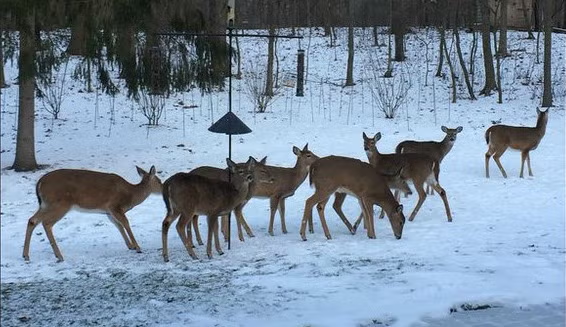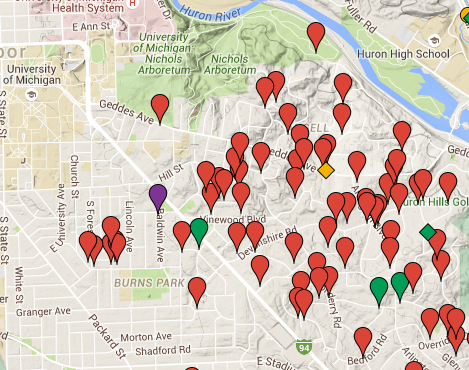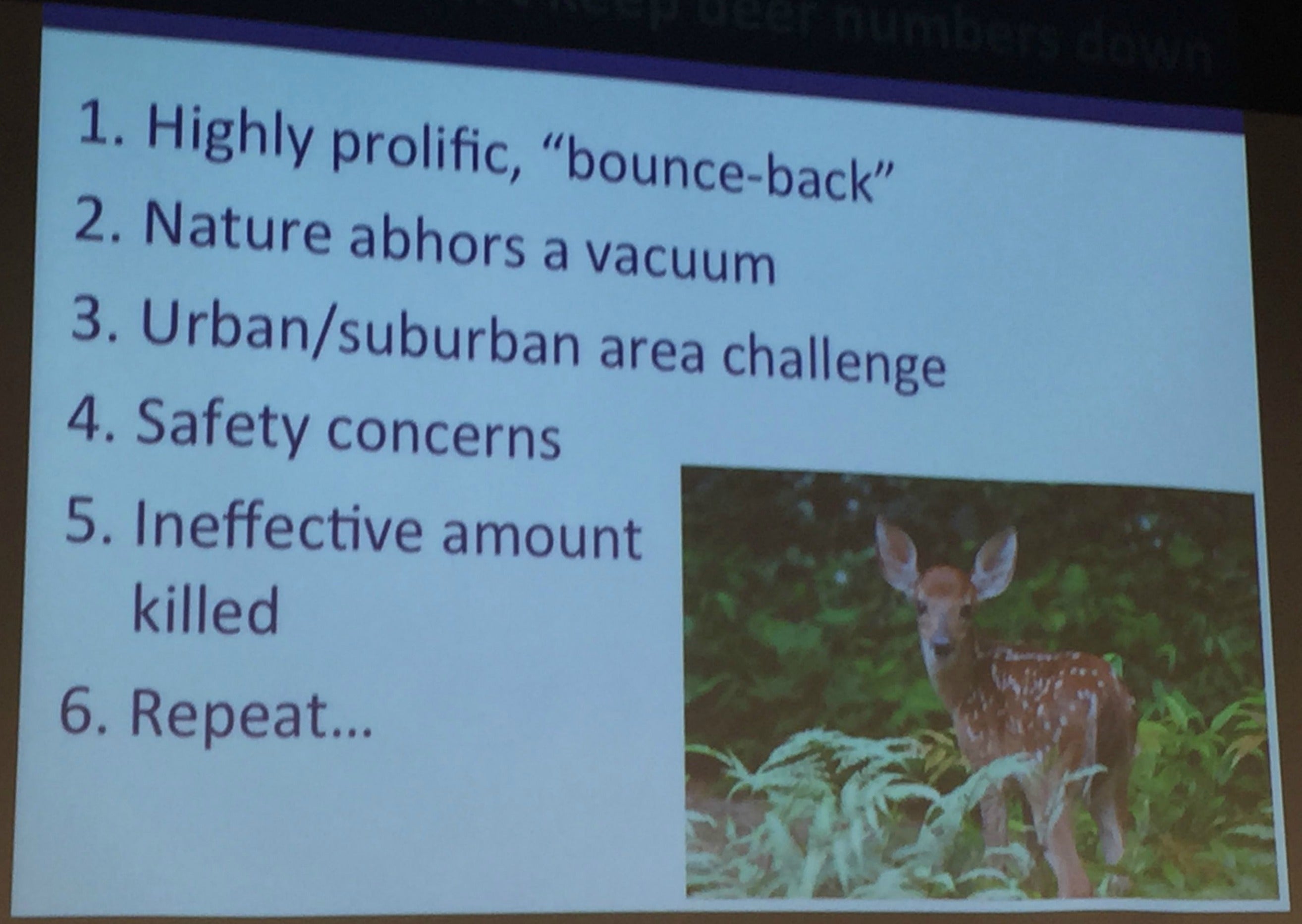Summary: Following a controversial deer cull, the city of Ann Arbor is considering non-lethal methods to deal with its burgeoning deer population. The Humane Society of America (HSUS) has aggressively promoted these methods in Ann Arbor and elsewhere but their scientific rationale is misleading at best. This post discusses biological misinformation at the heart of the HSUS deer campaign.
Whitetail deer photographed from an Ann Arbor home on January 20, 2016. The large numbers of yearlings suggest that the herd is undergoing an exponential growth phase.
Ann Arbor recently approved a deer cull in which marksmen shot 63 deer; the venison was distributed to the needy. Although the cull was planned with public input and an emphasis on safety, opposition groups protested relentlessly and filed lawsuits (some still pending) to halt the cull. A full listing of MLIVE articles on the topic can be found here. The timeline and local political context can be found here and here.
There has been debate about whether the population density of deer in Ann Arbor is high enough to merit a cull (link). Deer are heterogeneously distributed across the city, and while some parks may have few deer, abundant deer in other parks have caused significant browsing damage. In light of the high growth rates of deer in urban settings, a steady increase in deer-vehicle collisions, and the inevitable arrival of deer ticks (Ixodes scapularis) and Lyme Disease, the decision to implement a cull seemed like the wise choice.
The Humane Society of Huron Valley (HSHV) has led anti-cull protests, but many of their talking points can be traced to the Humane Society of the United States (HSUS). HSUS is a lobbying group with economic clout comparable to the NRA. In 2014 it took $130 million in donations, about 1% of which was distributed to local animal shelters. Both humane societies agree that deer should be treated with pet gloves, that is, neutered before being released to the wild. Trap, neuter, release (TNR) has been used on wild horses (at great expense) and feral cats, so far unsuccessfully. Neutered feral cats consume a steady diet of birds, reptiles and small mammals, but HSUS never mentions the ecological cost of TNR.
Deer sighting maps show that deer have moved well beyond the confines of Ann Arbor natural areas (January 6, 2016 – updated maps and City deer survey maps are available at the WC4EB website). The City’s aerial survey shows deer concentrated along the Huron River. Note U-M campus in NW quadrant.
In August of 2015 HSUS Chief Scientific Officer Stephanie Boyles gave a presentation to City Council on lethal and non-lethal methods and toured some local parks and natural areas. The MLive headline read “Humane Society concludes deer fertility control is feasible in Ann Arbor“. Ms. Boyles sent a follow up Letter to Council outlining the steps involved in establishing collaboration between HSUS and the City of Ann Arbor to test non-lethal approaches.
Boyles gave a dismal view of deer culls in her August 12, 2015 report to the City:
…deer culling programs generate an endless succession of removal and replacement in which animals die unnecessarily while the root causes of problems go unaddressed. As long as attractive habitat remains accessible and no effort is made to suppress the deer population growth rate, the remaining deer will continue to breed resulting in a perpetual kill cycle.
For these reasons, lethal methods should only be used as a last resort when other deer conflict resolution methods, such as site-specific mitigation (i.e. exclusion, repellents, etc.) and population growth suppression methods, such as immunocontraception and surgical sterilization, have been explored and exhausted.
The two categories of non-lethal method are (1) immunocontraceptives (aka birth control vaccinations), and (2) surgical sterilization. At this stage the use of immunocontraceptives is too impractical to dwell on. The fertility suppression of the vaccine PZP (favored by HSUS) is temporary and requires boosters that become exceedingly difficult to administer as deer learn to avoid capture (Boulanger et al. 2012). Moreover, it is not approved for use by the Michigan DNR and causes repeated estrous cycles, i.e. the rut would be yearlong, not just in the fall. The National Parks System has studied non-lethal methods extensively and rejected them as not practical and/or effective (NPS Fire Island Study).
Boyle’s assertion that periodic culls do not lower demographic growth is puzzling. Killing a female deer forfeits her reproductive success as would a sterilization. In addition it removes the adult deer. This statement only makes sense if one accepts two or three tenuous ideas about deer biology: the vacuum effect, bounce-back effect and the placeholder effect. The first two ideas are often cited by ant-cull activists as evidence of why a cull is a waste of taxpayer money. The third seems to be an invention of the HSUS.
According to Jill Fritz, Michigan Senior State Director of HSUS, deer culls won’t work because of “bounce-back” and “vacuum” effects. She also stated that culls can produce orphaned fawns. In fact, by winter, “fawns” are reproductively mature and often pregnant. MSU deer colloquium
1. Vacuum effect. This is the idea that deer from outside of the cull area will quickly replace the lost deer through dispersal, because “nature abhors a vacuum” (see photo above). Unlike gas molecules used in this analogy, female deer have strong site fidelity, and when a matriarchal group is removed it can take years for nearby deer to populate the emptied landscape (Porter et al. 1991). Oyer and Porter (2004) tested this idea by removing deer from a locality within a large forested area in New York. The relatively low deer density in the test site persisted for 5 years.
2. Bounce-back effect. This is the idea that deer adjust their reproductive output to compensate for the loss of culled deer. From the HSUS website:
Deer are highly prolific, and their high reproductive rate can quickly compensate for declines in their population. When deer numbers are reduced after killing programs, the remaining female deer will often respond to greater food abundance by giving birth to twins or triplets. Fawns also have higher survival rates and earlier onset of sexual maturity. The end result is a quick “bounce-back” in numbers.
Under conditions in which deer are at starvation-level overpopulation (i.e. at biological carrying capacity), the removal of some deer may cause an increase in food supply. This may cause some does to increase their reproductive output from zero or one fawn back to the normal two fawns and enable the survival of fawns that otherwise might have starved. It is generally agreed that the Ann Arbor deer population has not reached its biological carrying capacity.
3. Placeholder effect. This is the idea that sterilized females keep landscape-level deer densities low due to their territoriality. From Boyles’ February 17, 2009 letter to administrators of the Valley Forge National Historical Park:
Sterilization is superior to lethal control in that it leaves animals in a population as “placeholders” that are reproductively “dead ends” yet continue to occupy consistent home ranges and exhibit natural herding behaviors. The presence of these adult “placeholders” ensures continuity in the social framework of the herd while limiting the number of young and more mobile animals that might pose increased risks of collisions with vehicles and dispersal to adjoining private properties.
The placeholder hypothesis seems to have no factual basis. I asked Michigan DNR Deer Specialist Chad Stewart about it. He writes: “The only time I have seen “territoriality” in does is over feed or fawn protection.” If sterile does are protecting fawns, this will only be an ephemeral behavior, as “fawns” by mid-winter are reproductively mature and no longer require maternal protection.
Thus, in the view of HSUS, non-lethal methods are superior to lethal methods because sterile does keep migrants out (placeholder and vacuum fallacies) while preventing compensatory population growth (bounce-back fallacy).
This is just a sample of the misinformation that can be found in HSUS public outreach material. They state that deer densities have nothing to do with Lyme disease (see Kilpatrick et al. 2014 and this post for evidence to the contrary), that culls orphan fawns (1. there are no fawns during a winter cull; and 2. the father – a roaming buck – is already long gone). Boyles provided misleading information about the ease of surgical sterilization, indicating that an ovariectomy is just a 20 minute operation (see slideshow). She failed to mention the extraordinary effort needed to capture and transport deer from forest to operating table. The Highland Park, IL sterilization program required 690 person-hours to sterilize 100 deer (Boulanger 2014). Cayuga Heights, NY spent nearly $3,000 per deer after the easy ones were captured.
Misinformation about deer biology and management is widely disseminated in save-the-deer fact sheets. This has created a situation in which even highly educated people have difficulty deciding what or whom to believe. The anti-cull movement has parallels to the anti-vaccination movement. Both are grounded in ideology, thrive on creative interpretations of science, and find clever ways to discredit scientific results. The HSUS touches on its ideological mission in a letter to Valley Forge Natural Historic Park:
This [deer management] is a highly contentious issue in which scientific uncertainty and human value systems meet head-on within a social framework that, frankly, views deer as a predominantly consumable and sustainable resource providing recreational opportunities. This is neither the mission nor the mandate of NPS [National Park Service], but the larger social context into which it must fit its own goals and plans. The HSUS regards the “standard” social model to be a vortex into which agencies like NPS might be easily pulled.
Why would a lobbying group with enormous financial resources fan the flames of wildlife wars in Ann Arbor and other communities? The ulterior motive of the HSUS — or at least it would seem — is to radically change the “standard” social model so that activities like deer hunting are seen as barbaric and inhumane by future generations. Given the kinds of behavior that we have witnessed — for example, a deer carcass investigated as homicide by the HSHV, or a “deer lives matter” ceremony honoring the lives of 63 culled deer — animal rights groups can claim some small successes. This is unfortunate, because deer hunting (or its recent urban counterpart – the cull) has long been an integral part of human ecology. And, in the absence of other predators, killing healthy deer for venison remains the most natural and effective way to limit deer abundance and sustain a broad diversity of native species.
Disclaimer: These are my views and not official views of the University of Michigan.
References
Boulanger, J. D., P. D. Curtis, E. G. Cooch, A. J. DeNicola (2012) Sterilization as an alternative deer control technique: a review. Human–Wildlife Interactions 6(2):273–282
Kilpatrick, H. J., LaBonte, A. M., Stafford, K. C. (2014) The relationship between deer density, tick abundance, and human cases of Lyme disease in a residential community. Journal of Medical Entomology 51(4):777-84.
Oyer, A. M., W. F. Porter (2004) Localized management of white-tailed deer in the central Adirondack Mountains, New York. Journal of Wildlife Management 68(2): 257-265.
Porter, W. F., N. E Matthews, H. B. Underwood (1991) Social Organization in Deer: Implications for localized management. Environmental Management 15(6): 809-814.
Further reading:
The book Nature Wars, by Jim Sterba, places urban wildlife conflicts in their broader context, including background on the HSUS. Deer are just one of “problem” species discussed.
Richard Conniff’s blog Strange Behaviors explores the problems with cat and horse sterilization programs in his writings, and recently featured an Ann Arbor/HSUS post.
Vivienne Armentrout’s blog Local in Ann Arbor explains the vacuum and bounce-back effects in non-technical terms, along with other Ann Arbor perspectives.
The Washtenaw Citizens for Ecological Balance (WC4EB) is a group of citizen scientists who have studied the local deer problem and aggregated cull-related information on the WC4EB website.
The most rigorous tests of lethal and non-lethal methods is the Cornell Study. Here is some associated outreach materials and a description of how surgically sterilized does acted as “buck magnets” at Cornell.
Before coming to Michigan, Chad Stewart worked as deer specialist in Indiana and helped produce the highly readable technical guide for urban deer management. He is working on a much-needed guide for Michigan.



Bravely done professor I am sure you will get more then a few comments.
Thank you, Thank you! Unfortunately, like anti-vaxxers, StopTheShooters plug their ears and sing “lalala” to science, scientific opinion, reason, and the other things that make their smartphone possible.
Excellent summation Christopher.
This article can’t even be considered comparable to “pseudoscience”. It completely ignores the hundreds of peer review publications with data that clearly shows BIRTH CONTROL FOR WILFLIFE WORKS! Again, what is presented here is strong bias on how wildlife should be manage – ie. kill them!
The author also ignores numerous publications on the successful implementation of TNR (Trap-Neuter-Return or Release) for cats. Our organization could give this author a personal tour of the many “sites” in our city that are no longer over run with cats – thanks to a good TNR program?
Lastly, many of us want to live humanely with our wild life – ie. urban deer. And we will NEVER permit people who simply enjoy killing them onto our properties!!
Dr. Schafer, If there are hundreds of studies showing that birth control can effectively control urban deer populations, outside of islands or fenced-in areas, please provide even a single example. I seriously doubt that you will find one.
I don’t think you have thought deeply about how deer live and die in nature. The cull provides an instantaneous end to a fully natural life. Under a birth control scenario, deer are subjected to field operations and/or drugs that alter their core reproductive behavior and biology. Sterilized deer may live longer than pristine deer, but they can be stressed by being continually receptive, and for bucks this can mean erratic behavior and a higher likelihood of deer-vehicle collisions. When sterilized deer die, the death will certainly be more painful than the bullet. It may be a slow death by starvation or disease, or a somewhat faster but still painful death by car.
Also, please send any references demonstrating that TNR for cats works effectively. And let me know if you are similarly concerned about the wildlife that these sterilized cats will consume until they meet their natural end.